Posted by Kristen Goodhue on July 21st, 2014
by Dejeanne Doublet
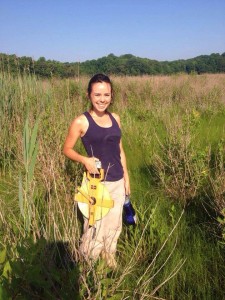
SERC intern Dejeanne Doublet heads out to sample marsh elder.
(Megan Palmer)
As we’re knee-deep in the marsh surrounding the Chesapeake Bay, working under the relentless sun during 90-degree weather with 90 percent humidity, sweat dripping down our faces, waving off the summer bugs and trying to collect as much field data as possible, the idea of winter becomes abstract and far-fetched. It’s hard to believe we are out here in the blazing heat of summer studying the effects of this past winter— one of harshest winters this area has endured in many years.
Click to continue »
Posted in Climate Change, Ecology, Extreme Weather, Interns, SERC Sites and Scenes | Comments Off on Intern Logs: A Summer Quest
to Understand Winter
Posted by Kristen Goodhue on July 17th, 2014
By Sarah Hansen
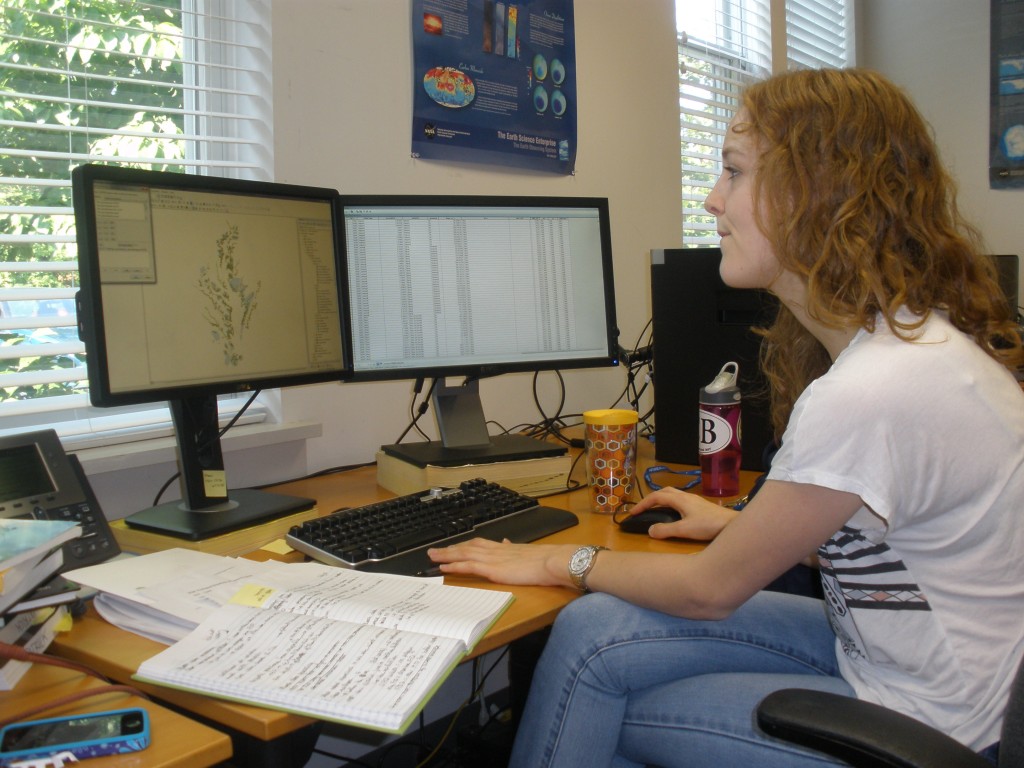
SERC intern Bridget Smith, immersed in a sea of environmental data. (SERC)
Underwater plants like sea grasses provide habitat and feeding areas for a wide range of aquatic life. They also help filter the water and put the brakes on erosion. But in Chesapeake Bay, the coverage of underwater plants, or submerged aquatic vegetation (SAV), has been low for decades, and restoration attempts have had mixed results. That’s why this summer, Smithsonian Environmental Research Center intern Bridget Smith is grappling with 28 years of data to explore which of a host of factors affects SAV in the Bay and how.
Click to continue »
Posted in Ecology, Interns, Land Use, SERC Sites and Scenes, Water Quality | Comments Off on Using Computer Models to Help Rescue Bay’s Underwater Flora
Posted by Kristen Goodhue on July 9th, 2014
By Sarah Hansen
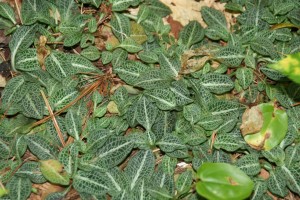
A cluster of downy rattlesnake plantain, the orchid species SERC intern Christopher Robinson is studying this summer. (Wikimedia Commons user Cdc25A)
Orchids are beautiful plants to be treasured, and fungi are gross moldy blobs to avoid at any cost. At least, that’s what some people may think. But it turns out that no orchid can germinate and grow without a fungal partner. Smithsonian Environmental Research Center scientist Melissa McCormick has been learning about the relationship between orchids and fungi for 15 years. This summer, though, intern Christopher Robinson is helping put a new twist on the research. Click to continue »
Posted in Ecology, Interns | Comments Off on Orchid, Fungi and Bacteria Relationships:
“It’s Complicated”
Posted by Kristen Goodhue on July 8th, 2014
By Sarah Hansen
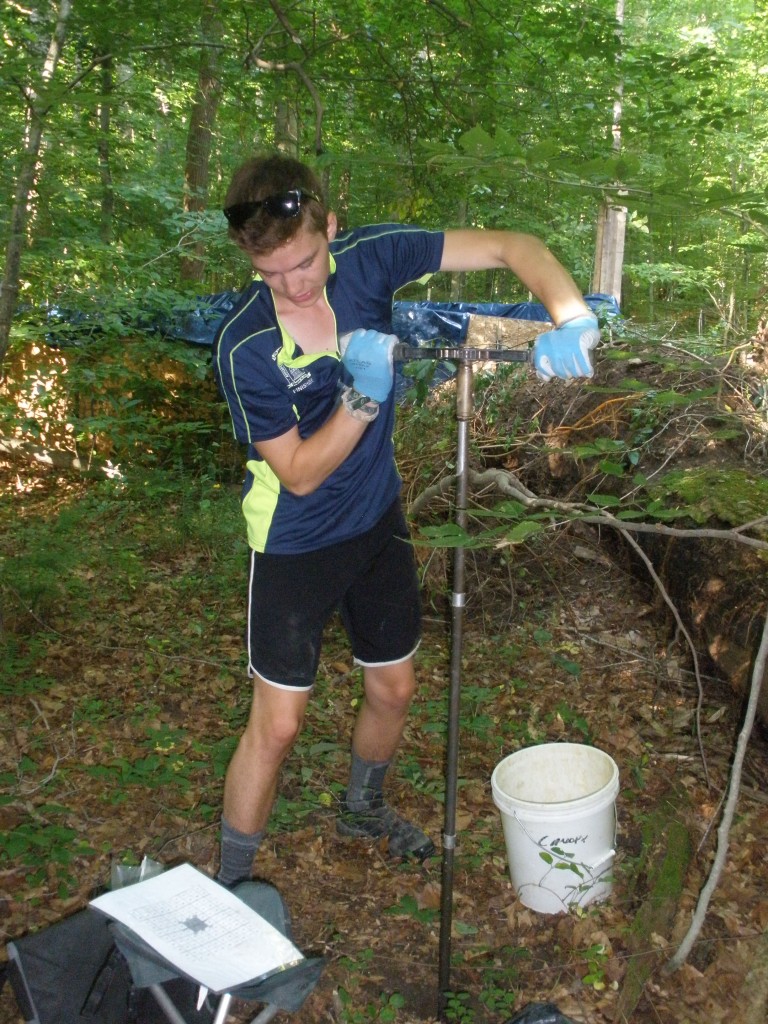
James Biddle, SERC intern, twists a soil augur into the ground to collect a 50- to 100-centimeter deep soil core.
It’s well-known that carbon dioxide levels are rising in Earth’s atmosphere and that extra CO2 contributes to climate change. You might also have learned that trees are “carbon sinks” – they take carbon out of the air and store it in their trunks, roots and leaves. But what about carbon in forest soil?
If you’re not sure, you’re in good company. “We’re just learning how carbon moves through the forest at the surface, and that’s the most accessible part of the forest,” said Sean McMahon, senior scientist at the Smithsonian Environmental Research Center (SERC). “Below ground is much more of a mystery.” Click to continue »
Posted in Climate Change, Ecology, Interns | Comments Off on Getting to the core of carbon in forest soils
Posted by Kristen Goodhue on July 8th, 2014
by Kristen Minogue
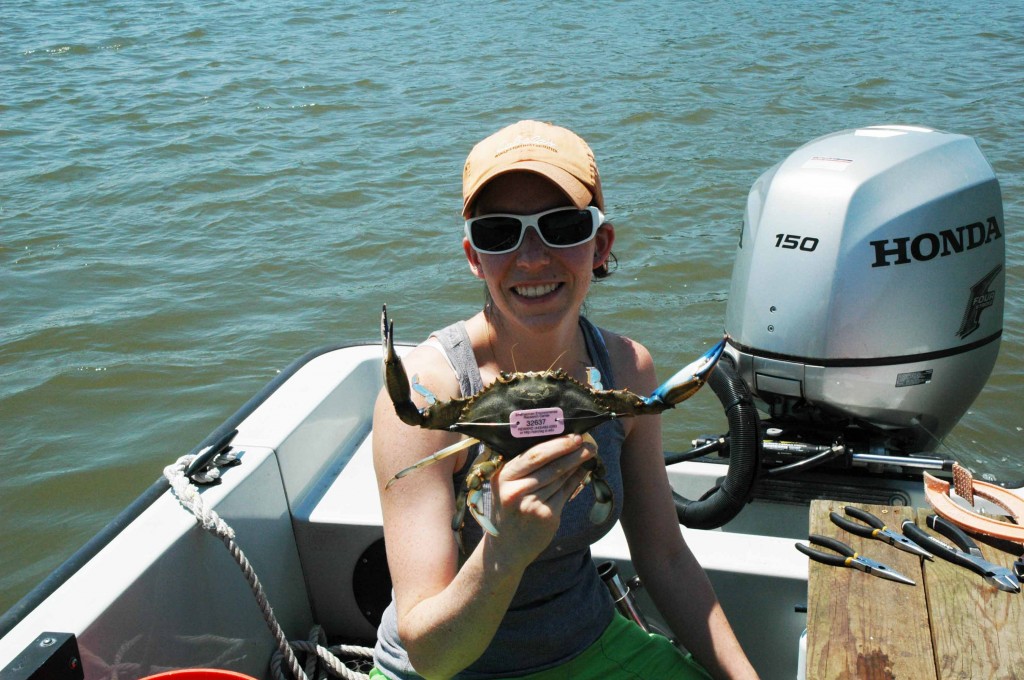
Technician Laura Patrick holds up a blue crab caught in the Rhode River. (SERC)
This summer and fall, biologists at the Smithsonian Environmental Research Center are looking to tag 10,000 blue crabs in Chesapeake Bay. They’re pursuing the project in spite of the two-year slump the crabs have suffered in the latest reports of the Chesapeake Bay Stock Assessment Committee. They’re hoping some of those crabs will help answer two unresolved questions on the path to recovery: the role of recreational crabbing, and the struggling population of adult females.
Every year watermen on Chesapeake Bay haul in between 40 and 110 million pounds of blue crabs on trotlines or in crab pots. The vast majority come from commercial watermen who rely on the crustaceans for their livelihoods. But recreational crabbers also take their share, and today no one knows exactly how large or small that share is.
“We really have very little idea how big the recreational fishery is now,” says Matt Ogburn, a postdoc at SERC’s Fish and Invertebrate Ecology Lab. Click to continue »
Posted in Ecology, Fisheries, SERC Sites and Scenes | 1 Response »
Posted by Kristen Goodhue on July 3rd, 2014
By Sarah Hansen
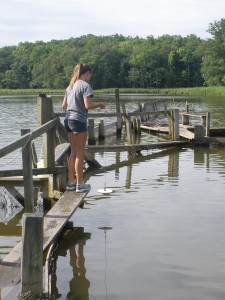
Shelby Paschal, SERC intern, takes the “Secchi depth,” a measure of water clarity, while balancing on the fish weir.
In the Chesapeake Bay region, water quality is a big deal. It can affect populations of economically important animals such as crabs and oysters, or shift ecological relationships among other species. Differences in water quality might even determine whether an invasive species can establish a foothold in the Bay.
But water quality is a nebulous thing. Even collecting water samples can be tricky, something intern Shelby Paschal knows first-hand.
“This is our obstacle course training,” Paschal says with a laugh, after a climbing onto a rickety fish weir at the Smithsonian Environmental Research Center (SERC). Paschal and the rest of the Nutrient Lab, headed by senior scientist Tom Jordan, are running one piece of an ambitious 6-year project studying the effects of multiple factors in shallow near-shore habitats. These critical habitats for small fish, crabs, and plants face threats from invasive species and construction, as well as from degradation of water quality caused by release of excessive nutrients from cropland into the Bay. Click to continue »
Posted in Publications | 2 Responses »
Posted by Kristen Goodhue on June 23rd, 2014
by Sarah Hansen
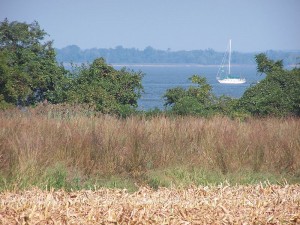
A buffer on the Chester River in Queen Anne’s County, MD protects the river from nitrogen pollution. (USDA)
Nitrogen pollution in the Chesapeake Bay became a serious concern in the mid-20th century after the advent of nitrogen-rich chemical fertilizers. Bay restoration efforts have reduced nitrogen pollution somewhat, but achieving healthy nitrogen levels in the Bay is still a long way off. Croplands remain an important source of the nitrogen that pollutes Chesapeake Bay.
Don Weller, senior scientist at the Smithsonian Environmental Research Center, and his colleague Matthew Baker, associate professor of geography and environmental systems at the University of Maryland, Baltimore County, report in a new study that just over half the nitrogen from croplands might never reach the Bay—if all crop fields were protected by streamside forests and wetlands.
Click to continue »
Posted in Ecology, Land Use, Publications, Water Quality | Comments Off on How much could streamside forests reduce nitrogen pollution in the Bay?
Posted by Kristen Goodhue on June 20th, 2014
By Sarah Hansen
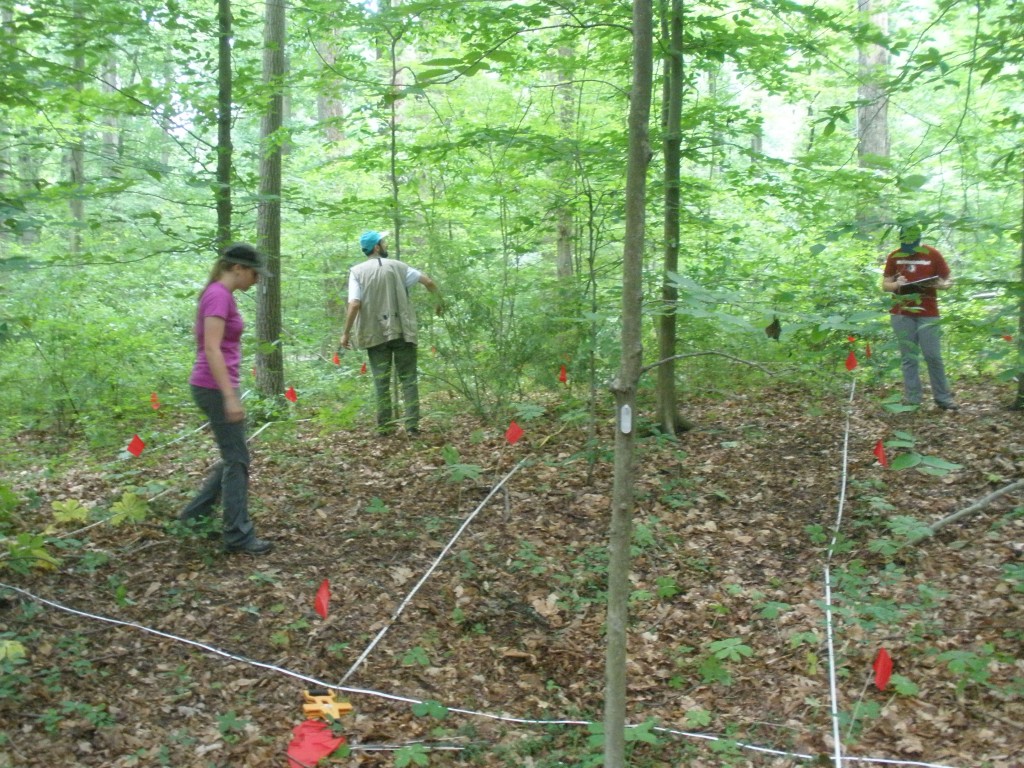
An upland forest plot at SERC. Lauren Emsweller, David Gorchov, and Julia Mudd (left to right) search for five invasive plant species.
Invasive plants are rampant throughout the United States. Some have been here for tens or even hundreds of years, while others are relative newcomers. They compete with native plants for resources, and more often than not they win the fight.
David Gorchov, visiting scientist from Miami University of Ohio, is leading a project to map five invasive plant species in upland forests at the Smithsonian Environmental Research Center (SERC). In particular, he’s interested in how gaps in the forest canopy, usually created by a tree falling, affect the abundance of these invasives. One of his graduate students, Lauren Emsweller, is here working on the project for her master’s thesis. Julia Mudd, a SERC intern from Florida State University, is getting college credit to help them out.
“There are a few studies that have looked at the importance of gaps, but there’s none that have done complete maps like this that I’m aware of,” said Gorchov.
Click to continue »
Posted in Ecology, Interns, Invasive Species, SERC Sites and Scenes | 1 Response »
Posted by Kristen Goodhue on June 17th, 2014
by Dejeanne Doublet, terrestrial ecology intern
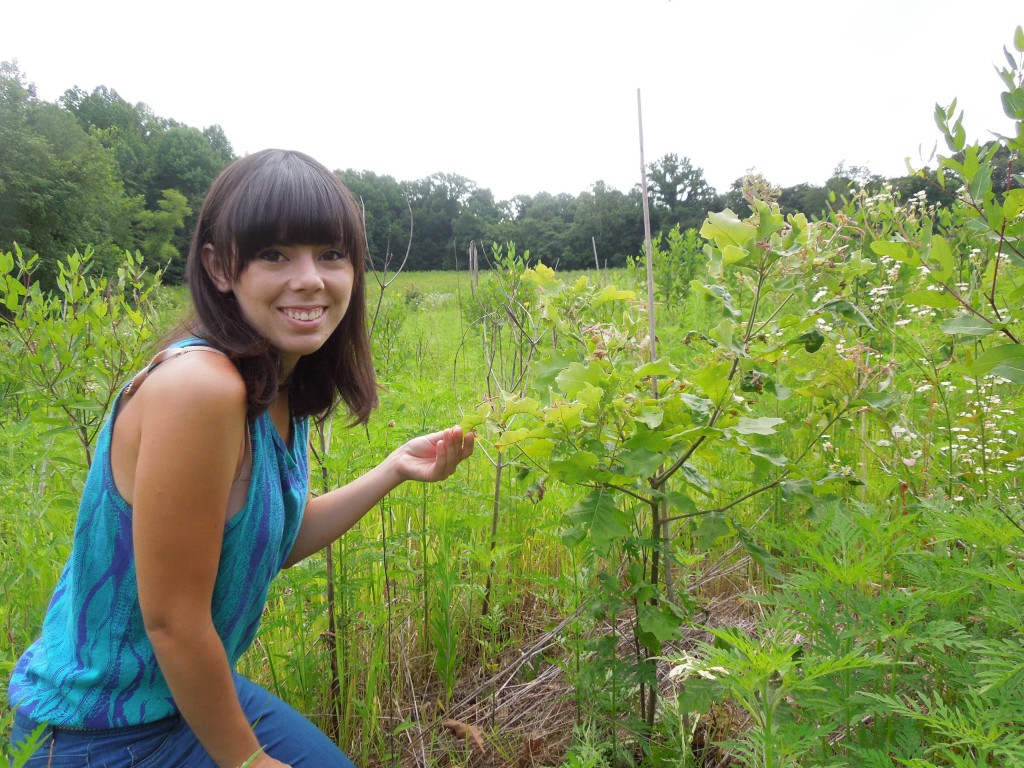
Dejeanne Doublet inspects a red oak in BiodiversiTree. (SERC)
Ecological research usually doesn’t evoke thoughts of Stephen King horror movie scenes. Working with plants and animals in the open air shouldn’t provoke nightmares of being drenched in blood. Green is a very different color from red.
However, fellow intern Megan Palmer and I learned on our first week that sometimes, just sometimes, Stephen King references are the best way to describe a day’s work in the field. During our first days at the Smithsonian Environmental Research Center, Palmer and I were asked to do something that made my non-red-meat-eating stomach turn.
“Go spray pig’s blood on all our trees,” Dr. John Parker, the lead terrestrial ecology scientist and our boss told us during one of our first meetings with him. He was referring to the 24,000 tree saplings planted last summer as part of a 100-year experiment on biodiversity, fittingly called BiodiversiTree.
Click to continue »
Posted in Ecology, From the Field, Interns, Land Use, SERC Sites and Scenes | Comments Off on Intern Logs: A Bloody Welcome
Posted by Kristen Goodhue on June 13th, 2014
By Sarah Hansen
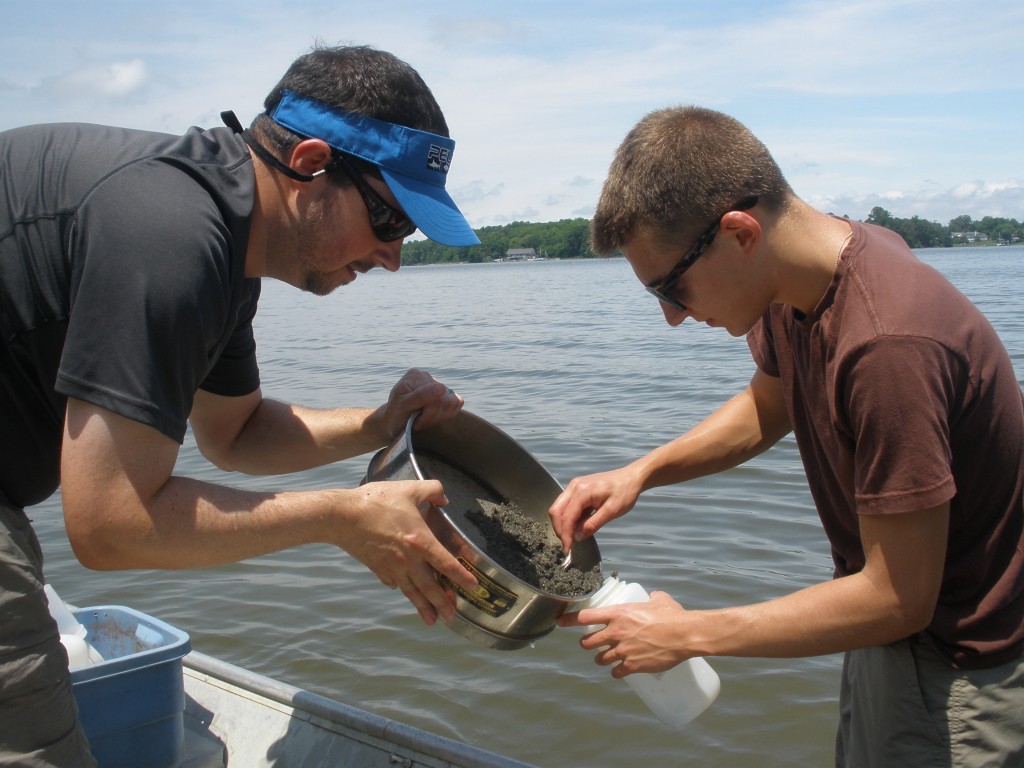
Dean Janiak (left) and Ben Rubinoff collect a sample from the Rhode River.
Most of us think of the Chesapeake Bay as a single entity – one big body of water. But Smithsonian Environmental Research Center (SERC) ecologist Dean Janiak and his intern, Ben Rubinoff, have a more nuanced perspective. They’ve collected more than 150 samples from eight different habitats within the Bay and along its shoreline that contain mud, sand and lots of tiny animals.
Their ultimate goal: Discover how differences in habitats in the Rhode River (a sub-estuary of the Chesapeake Bay) can change biodiversity among creatures at the bottom of the river, and how those patterns change over time. If it turns out that some habitats host more diverse animal communities than others, land managers can focus conservation efforts on those areas. Click to continue »
Posted in Climate Change, Ecology, Interns, Publications | Comments Off on Seeking Life in the Mud











